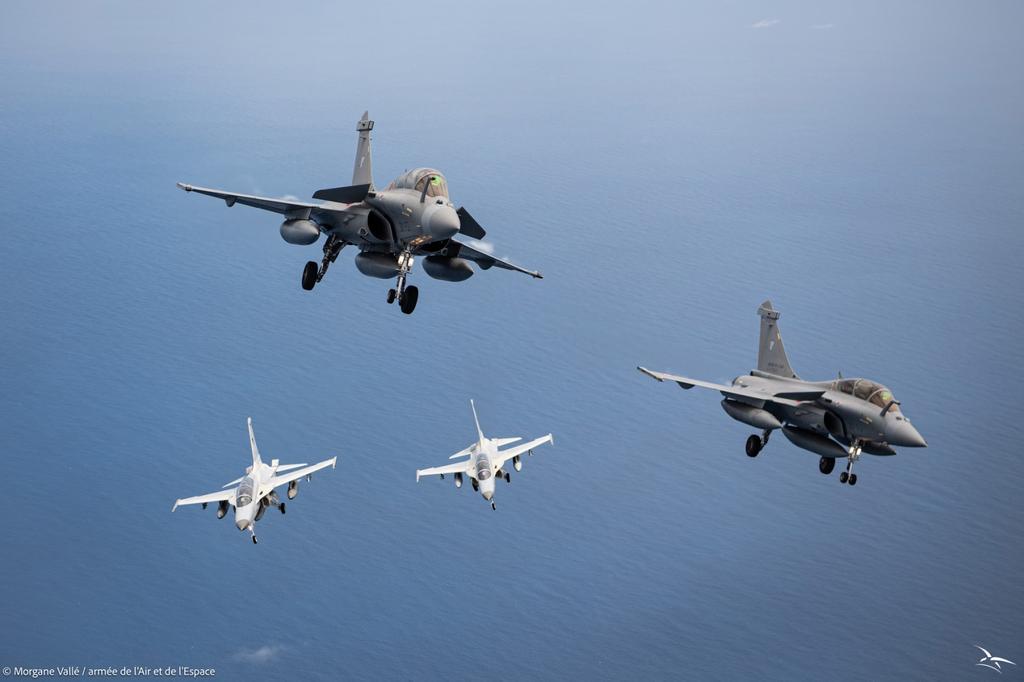The skies over West Zambales were alive with action on July 30 as pilots from the PAF engaged in “basic fighter maneuvers” (BFM) alongside their counterparts from the French Air and Space Force (FASF).
The joint drills featured two Rafale jet fighters from the FASF. Col. Rifiel Santiago, acting chief of the PAF’s public affairs office, remarked on the exceptional display of tactical skill.
“Both Air Forces demonstrated their tactical maneuvering skills and techniques in a simulated combat scenario, showcasing their proficiency in air-to-air combat,” he stated.
On July 29, the collaboration kicked off with a joint flight involving two FA-50PH jets from the Philippine Air Force (PAF) and two Rafale jets, an A330M transport aircraft, and an A400M Airbus military transport aircraft from the FASF. This mission aimed to exhibit the Rafale jets’ advanced air-to-air refueling capabilities over West Zambales.
These exercises form a critical part of the French military’s Projection of a Heavy Air Package in Southeast Asia (PEGASE) 2024 initiative.
According to Santiago, PEGASE 2024 is designed to bolster military partnerships, enhance operational readiness, and ensure regional stability through collaborative training and strategic deployments.
The high-flying collaboration between the PAF and FASF highlights the tactical skill of both forces while emphasizing the crucial role of international military cooperation in sustaining regional peace and security.

Further, the French Air Force paid a courtesy visit to the Armed Forces of the Philippines (AFP) General Headquarters to explore opportunities for enhanced military cooperation and mutual defense between France and the Philippines.
Meanwhile, in addition to their latest drills with the French Air Force, the PAF was recently involved in similar training exercises with other countries as a part of Australia’s Pitch Black exercise.
On July 15, two FA-50PH jets engaged in a basic fighter maneuver (BFM) exercise alongside two Royal Australian Air Force (RAAF) F-18 Hornets. The following day, July 16, the PAF’s FA-50s conducted another BFM exercise with F-16s from the Indonesian Air Force.
Comparative Overview Of FA-50 & Rafale Fighter Jets
In the realm of fighter jets, the FA-50 and Rafale epitomize two distinct philosophies in air combat, each reflecting unique design priorities and capabilities.
The FA-50, developed in South Korea, is an advanced iteration of the T-50 trainer aircraft. Designed primarily as a light combat platform, the FA-50 offers a cost-effective solution for nations seeking a balance between air-to-ground and air-to-air capabilities.
Its focus on affordability and operational efficiency makes it an attractive choice for countries operating within budget constraints.
The FA-50 is designed to deliver dependable performance cost-effectively, making it suitable for various operational requirements without the financial strain associated with more advanced fighter aircraft.
On the other hand, the Rafale represents French aerospace engineering at its pinnacle, embodying a versatile multirole fighter jet capable of executing a wide array of missions.
Its design focuses on delivering superior performance across various combat scenarios, including air superiority, ground attack, and carrier-based operations. The Rafale’s advanced features are aimed at ensuring high-end performance and flexibility, making it a formidable asset in diverse combat environments.
In terms of avionics, the FA-50 is equipped with modern systems such as a heads-up display (HUD), multi-function displays (MFDs), and radar systems tailored to its operational role. However, it lacks some of the more sophisticated technologies found in high-end fighters, which may limit its advanced operational capabilities compared to its more expensive counterparts.
F-16s “Sitting Ducks” For Russian MiG-31 Fighters? Putin Warns Of Consequences Over Fighting Falcons
In contrast, the Rafale aircraft is outfitted with state-of-the-art avionics, including the RBE2 radar, the SPECTRA electronic warfare suite, and a highly integrated cockpit. These advanced systems provide enhanced situational awareness and powerful electronic countermeasures, elevating the Rafale’s status as a leading combat platform in its class.
Performance metrics further emphasize the differences between these two jets. The FA-50 can reach speeds up to Mach 1.5 and boasts a range of approximately 2,592 kilometers (1,610 miles). It is capable of carrying a range of air-to-air and air-to-ground munitions, including guided missiles and bombs.
Conversely, the Rafale achieves speeds around Mach 1.8 and has a longer operational range of about 3,700 kilometers. Its versatility allows it to carry an extensive array of munitions, such as Meteor and MICA missiles and various precision-guided bombs.
The Rafale’s capability for aerial refueling extends its operational range significantly, enhancing its effectiveness in extended missions.
Both aircraft have achieved notable success in the export market within their respective categories. The FA-50 is utilized by several countries, including South Korea, the Philippines, Poland, and Thailand, primarily for light combat and training.
The Rafale, meanwhile, is operated by the French Air and Space Force and Navy, along with international customers such as Greece, India, Croatia, Egypt, and Qatar. Its wide-ranging applications, from carrier-based operations to land-based deployments, highlight its advanced capabilities and adaptability.
- Contact the author at ashishmichel(at)gmail.com
- Follow EurAsian Times on Google News